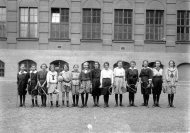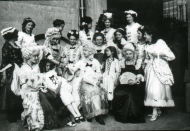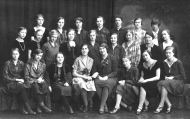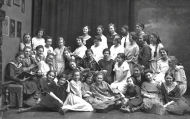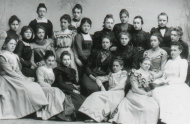|
|
|
|
|
|
|
|
|
|
|
|
|
|
|
|
|
|
|
|
|
|
|
|
|
|
|
|
|
|
|
|
|
|
|
|
|
|
|
|
|
|
|
|
|
|
||||||||||||||||||||||
|
Alice Nathan Born: 1899 in Augsburg. Father’s occupation: factory-owner. Alice’s father was Rudolf Nathan (b. 1872 in Ulm), her mother was Lina, née Bernheim (b. 1874 in Ulm). Alice had an older sister, Gertrud, and a younger brother, Ernst (b. 1905). The factory “R. Bernheim” was located in Pfersee, near Augsburg (since 1911, it has been a district of Augsburg). It produced waterproof chemical substances and other products for the textile industry. It had been founded with reference to Röse (Rosa) Bernheim, whose son, Siegfried Bernheim, took over the factory. Alice’s father, Rudolf Nathan, was a brother of Siegfried’s wife, Maria (b. 1873), and a joint owner of the firm. In 1933/34, the company was taken to court for tax evasion. As Alice’s parents had moved to Zurich, Switzerland, in 1931, Rudolf was out of reach of the court. Alice attended the “Municipal School for Daughters” (“Städtische Töchterschule”), which from 1914 on was called “Maria-Theresia-School”, from 1910 to 1916, at first in classes 2–4, then in classes 5 and 6 of the “Realabteilung” and finally for one year, in 1915/16, in the “school for women” (“Frauenschule”). In 1920, Alice married the lawyer Ludwig Regensteiner (b. 1889 in Augsburg). Ludwig worked in Munich together with Dr. Max Hirschberg and Dr. Philipp Löwenfeld. Their chambers specialized in criminal proceedings of a political character. Around 1929, the lawyer Elisabeth Kohn (b. 1902) joined them and “found a wide field of activity, committing herself to the SPD (Social Democratic Party of Germany), the German League for Human Rights, the ADGB (General Federation of German Trade Unions), and against the growing influence of National Socialism” (R. Weber). The Regensteiner couple lived at 20 Elisabethstraße, Munich. They had three children. |
From 1933 on, the National Socialists restricted Jewish lawyers. In 1937, the family Regensteiner emigrated to the USA, where Ludwig worked for a chemical factory up to 1954, then traded in chemicals. Elisabeth Kohn was deported from Munich to Kovno, Lithuania, in November 1941. After five days all the deportees were shot in Kovno. Ludwig Regensteiner died in Cranston, Rhode Island, in 1974. Alice Regensteiner, née Nathan, also died in Cranston in 1994. Alice’s father, Rudolf, died in 1961. Alice’s brother, Ernst, moved to Reutlingen in 1924, presumably in order to study there at a technical college (“Technikum für Textilindustrie”). Later he emigrated from Switzerland to the USA, as did his parents. He died in Providence, Rhode Island, in 1991. Alice’s aunt Maria (Marie) Bernheim and her husband moved to Munich. The widowed Maria was deported to Terezin in June 1942. She died there in the beginning of 1944. |
Sources and further reading: Bernd Serger and Karin-Anne Böttcher, Es gab Juden in Reutlingen. Geschichte—Erinnerungen—Schicksale. Ein historisches Lesebuch, Reutlingen, 2005, pp. 60–84 (on the Jewish students of the “Technikum für Textilindustrie”, Reutlingen). Erhard Bernheim, “Halbjude” im Dritten Reich. Die Erinnerungen des Augsburger Fabrikanten Erhard Bernheim, ed. Gernot Römer, Augsburg, 2000. Reinhard Weber, Das Schicksal der jüdischen Rechtsanwälte in Bayern nach 1933, Munich, 2006, p. 252 (on Ludwig Regensteiner). Reinhard Weber, “Dr. Elisabeth Kohn, Rechtsanwältin,” Mitteilungen des Münchener AnwaltVereins e.V., August/September 2003, pp. 8–9 (quotation). Terri d’Arrigo, “In Search of a Better Workout,” Diabetes Forecast, April 1, 2000, on the following website: www.highbeam.com/doc/1G1-61182034.html (on Alice’s granddaughter Judith Regensteiner, a medical scientist). |
|
|
Gertrud Nathan Born: 1898 in Augsburg. Father’s occupation: factory-owner. Gertrud’s father was Rudolf Nathan (b. 1872 in Ulm), her mother was Lina, née Bernheim (b. 1874 in Ulm). Gertrud had a younger sister, Alice, and a younger brother, Ernst (b. 1905). The factory “R. Bernheim” was located in Pfersee, near Augsburg (since 1911, it has been a district of Augsburg). It produced waterproof chemical substances and other products for the textile industry. It had been founded with reference to Röse (Rosa) Bernheim, whose son, Siegfried Bernheim, took over the factory. Gertrud’s father, Rudolf Nathan, was a brother of Siegfried’s wife, Maria (b. 1873), and a joint owner of the firm. In 1933/34, the company was taken to court for tax evation. As Gertrud’s parents had moved to Zurich, Switzerland, in 1931, Rudolf was out of reach of the court. Gertrud attended the “Municipal School for Daughters” (“Städtische Töchterschule”), which from 1914 on was called “Maria-Theresia-School”, from 1909 to 1915, at first in classes 1–6 (skipping class 2), then for another year in the “school for women” (“Frauenschule”). On April 23, 1914, a celebration took place, after which the pupils’ parents could look around the recently finished new building of the Maria-Theresia-School on Gutenbergstraße. On this occasion Ernst Johann Groth’s play Madame Breitkopf. Dramatisches Kulturbild aus dem deutschen Frauenleben der Rokokozeit was performed (“Madame Breitkopf: A dramatic picture from German women’s culture and life at the Rococo period”). Gertrud played the role of Gertrud Obermann from Goethe’s “Jugendkreis” (the friends of his youth; cf. Goethe’s letters from the Leipzig period and Dichtung und Wahrheit, Part II, Book 8). In 1920, Gertrud married Helmuth Bloch (b. 1893 in Mülhausen, Alsace). Helmuth was a co-owner of the textile factory “Bach & Bloch”. The couple lived at 14 |
Frölichstraße, Augsburg. They had three children, Wilhelm (b. 1917), Margarete (b. 1921), and Gabriele (b. 1930). In 1936, the family Bloch emigrated to the USA. Helmuth, who called himself Henry by now, worked as an insurance agent. He died in Los Angeles in 1954. Gertrud Bloch, née Nathan, also died in Los Angeles in 1987. Gertrud’s father, Rudolf, died in 1961. Gertrud’s brother, Ernst, moved to Reutlingen in 1924, presumably in order to study there at a technical college (“Technikum für Textilindustrie”). Later he emigrated from Switzerland to the USA, as did his parents. He died in Providence, Rhode Island, in 1991. Gertrud’s aunt Maria (Marie) Bernheim and her husband moved to Munich. The widowed Maria was deported to Terezin in June 1942, where she died in the beginning of 1944. Sources and further reading: Bernd Serger and Karin-Anne Böttcher, Es gab Juden in Reutlingen. Geschichte—Erinnerungen—Schicksale. Ein historisches Lesebuch, Reutlingen, 2005, pp. 60–84 (on the Jewish students of the “Technikum für Textilindustrie”, Reutlingen). Erhard Bernheim, “Halbjude” im Dritten Reich. Die Erinnerungen des Augsburger Fabrikanten Erhard Bernheim, ed. Gernot Römer, Augsburg, 2000. |
|
Dora Neuburger Born: 1912 in Augsburg. Father’s occupation: businessman. Address: 25 Völkstraße. Dora’s father, Gustav Neuburger (b. 1876 in Augsburg), died in 1918. Her mother was Josefine (“Josy”), née Lehmann (b. 1881 in Munich). The widowed Josefine was a co-owner of a wholesale business for shoes (“Neuburger & Frank”). Like Dora, her older sister Else also attended Maria-Theresia-School. Dora attended Maria-Theresia-School from 1924 to 1928 in classes 3–6; presumably, she had joined the school in 1922 in class 1. Dora (“Dorle”) married Karl Nikolaus Perlmutter (b. 1911 in Munich), who had studied medicine. The couple emigrated to the USA in September 1938. They lived in Savannah, Georgia. Karl Nikolaus, “Nick”, joined the US Army. The couple had a daughter and a son (b. 1945). Dorle Perlmutter, née Neuburger, died in the USA in 1999. Dora’s mother, Josy, and Dora’s sister, Else, had to move to 6 Halderstraße (near the synagogue) around 1942. This place was declared a “Jewish house” (“Judenhaus”) by the National Socialists. Josy was deported to the East and is declared dead. Dora’s maternal grandmother, Friedericke Lehmann, née Raff (b. 1857 in Jebenhausen), was deported from Munich to Terezin on August 1, 1942, and died there after two weeks and a half. A memorial stone for Gustav, Jossy, Else, and Dorle Neuburger is to be seen at the Jewish cemetery in Augsburg, Haunstetter Straße. |
Source and further reading: Andreas Heusler, Brigitte Schmidt, Eva Ohlen, Tobias Weger, and Simone Dicke with the collaboration of Maximilian Strnad, Biographisches Gedenkbuch der Münchner Juden 1933–1945, vol. 2 (M–Z), ed. Munich City Archives (“Stadtarchiv München”), Munich, 2007, pp. 245–46 (on Nick Perlmutter’s parents). |
|
Else Neuburger Born: 1915 in Augsburg. Father’s occupation: shoe manufacturer. Address: 25 Völkstraße. Else’s father, Gustav Neuburger (b. 1876 in Augsburg), died in 1918. Her mother was Josefine (“Josy”), née Lehmann (b. 1881 in Munich). The widowed Josefine was a co-owner of a wholesale business for shoes (“Neuburger & Frank”). Like Else, her younger sister Dora also attended Maria-Theresia-School. Due to poliomyelitis, Else was physically handicapped. She attended Maria-Theresia-School from January 1919 to 1923 in classes 2–6. In 1921, Else celebrated her “confirmation” in Augsburg, together with six other Jewish girls (Bat Mitzvah: the feast of religious maturity for Jewish girls; it can be celebrated individually on the Sabbath after the girl’s 12th birthday, but in Augsburg it was held annually or even after longer intervals for several age groups together, similar to the Protestant confirmation). Else and her mother, Josy, had to move to 6 Halderstraße (near the synagogue) around 1942. This place was declared a “Jewish house” (“Judenhaus”) by the National Socialists. Henry Landman (Heinz Landmann) lists Else among the many Jews who were deported from Augsburg to Auschwitz at the beginning of March 1943. A memorial stone for Gustav, Jossy, Else, and Dora Neuburger is to be seen at the Jewish cemetery in Augsburg, Haunstetter Straße. It says that Else “died in 1942”. Else’s mother, Josy, was deported to the East. Like Else, she is declared dead. Else’s maternal grandmother, Friedericke Lehmann, née Raff (b. 1857 in Jebenhausen), was deported from Munich to Terezin on August 1, 1942, and died there after two weeks and a half. Else Neuburger’s name is listed on a glass plaque of the shoah memorial that can be visited in Augsburg’s City Hall (artist: Klaus Goth). |
|
|
Elsa Neumayer Born: 1884 in Augsburg. Father’s occupation: businessman. Elsa’s parents were Leopold Neumayer (1857–91) and Nanette, née Gerstle (1862–1926). After Elsa, also her sisters Lina and Meta attended the “Municipal School for Daughters” (“Städtische Töchterschule”), which later was to be called “Maria-Theresia-School”. Elsa attended the “Töchterschule” from 1896 to 1900 in classes 1–4; the fourth class was the school-leaving class in those times. In 1904, Elsa married the businessman Martin Max Ambrunn (b. 1876) in Munich. Together with one of his brothers—another brother joined them later—, Max ran a men’s wear business in Munich, first on Karlsplatz, later at 17 Theatinerstraße. After the pogrom night in November 1938, the shop was closed and fraudulently put into liquidation. The procedure took more than a year. Thereby, “the emigration intended by the owners of the firm was delayed and their lives put at risk. The firm’s property, which consisted of 39,598 Reichsmark in December 1938, was reduced to 4429 Reichsmark by the activity of Mr. Männer [the liquidator] within a year” (W. Selig). The factory inspectorate was called in but did not put an end to the affair. One of the brothers Ambrunn, Ludwig, finally succeeded in emigrating to the USA in April 1940. The second, Julius, died in Auschwitz. In April 1941, Max and Elsa Ambrunn had to move to an internment camp in Clemens-August-Straße. On April 4, 1942, the couple was deported to Piaski, Poland. Their daughter, Brunhilde (b. 1906), could emigrate to South Africa. For two months, from April to June 1942, the engineer Arnold Hindls from Brno, Moravia, also lived in Piaski. For him this was but one of many deportation stations, between Terezin and Ossovo. In his memoirs, One Man Returned, published in Germany in 1965, he tells about Piaski: “Piaski is a small town in the |
Lublin district, surrounded by sand, swamps, and forests. The state road from Lublin to Chelm divides it into two parts. Therefore, the Jewish ghetto, which once was very large and inhabited by approx. 3000 local Jews, extended on both sides of the state road. Now, however, these two parts of the ghetto were each enclosed by high fences made of boards and barbed wire. They had big gates, which were permanently guarded and opened only twice a day, for one hour in the morning and one in the afternoon. The gates were closed towards the state road. ... The houses of the ghetto were mostly made of wood. They had only small yards and were closely boxed together, mostly built on ground level, only a few had one story. ...The small town had neither plumbing nor sewer. For the approx. 6000 inhabitants of the two parts of the ghetto...there was only one well with acceptable drinking water in the southern part. Each person was allowed to fetch only one ten litre bucket a day from that well. ... The SS commando which was in charge of the ghetto was stationed in a large, solid building on the outskirts of the southern part of the ghetto, at the state road. The SS could well observe both parts of the ghetto from the balcony of the building. Every visit by those ‘members of the master race’ meant slaps, kicks, and beatings. They confiscated food which was ‘not allowed’ and smuggled into the ghetto. ...Twenty to thirty people, nothing but skin and bones, died of hunger every day. ... In spite of these catastrophic provision conditions, all men and women who were able to work were recruited into groups to do excavation, gardening, and upkeep of the roads. ...Also within the ghetto, there was enough work to do, for instance, the cleaning and deepening of the drainage and gravel ditches, and the |
construction of latrines, latrines, and more latrines, of which there were never enough.” In the autumn of 1942, some Jews were taken from Piaski to Belzec, the others, approx. 4000, were taken to Sobibor, where they were killed. Immediately thereafter, the Piaski ghetto was occupied anew by other deported Jews. Elsa Ambrunn’s name is listed on a glass plaque of the shoah memorial which can be visited in Augsburg’s City Hall (artist: Klaus Goth). Aside: Elsa’s birth name was listed in Munich as “Else Neumeyer” (according to the Biographisches Gedenkbuch, vol. 1, 2003). Sources and further reading: Andreas Heusler, Brigitte Schmidt, Eva Ohlen, Tobias Weger, and Simone Dicke, Biographisches Gedenkbuch der Münchner Juden 1933–1945, vol. 1 (A–L), ed. Munich City Archives (“Stadtarchiv München”), Munich, 2003, pp. 56 and 59. Arnold Hindls, Einer kehrte zurück. Bericht eines Deportierten, Stuttgart, 1965, pp. 12–32. Wolfram Selig, “Arisierung” in München. Die Vernichtung jüdischer Existenz 1937–1939, Berlin, 2004, pp. 187–89 (on the liquidation of the “M. & J. Ambrunn OHG”, Munich). |
Lina Neumayer Born: 1889 in Augsburg. Father’s occupation: businessman. Lina’s parents were Leopold Neumayer (1857–91) and Nanette, née Gerstle (1862–1926). Like Lina, also her sisters Elsa and Meta attended the “Municipal School for Daughters” (“Städtische Töchterschule”), which later was to be called “Maria-Theresia-School”. Lina attended the “Töchterschule” from 1901 to 1905 in classes 1–5 (skipping class 3). Lina died in 1918. She is buried in the Jewish cemetery, Augsburg, Haunstetter Straße. |
Meta Neumayer Born: 1887 in Augsburg. Father’s occupation: businessman. Meta’s parents were Leopold Neumayer (1857–91) and Nanette, née Gerstle (1862–1926). Like Meta, also her sisters Elsa and Lina attended the “Municipal School for Daughters” (“Städtische Töchterschule”), which later was to be called “Maria-Theresia-School”. Meta attended the “Töchterschule” from 1899 to 1901 in classes 1 and 2. Meta married Salomon (Salo) Heymann (b. 1876 in Augsburg), a livestock dealer. Salo was an associate of a livestock company that was the most important of its kind in Augsburg before World War I (“Brothers Heymann”). The couple had three daughters, Ruth, Edith, and Lina Heymann, who attended Maria-Theresia-School just as their mother had years before. Meta Heymann, née Neumayer, died in Munich in 1936. She was buried in the Jewish cemetery, Augsburg, Haunstetter Straße. Salo was deported from Munich to Terezin in August 1942; having lived there for almost two years, he died on June 18, 1944. Aside: Meta’s birth name is spelled on her tombstone as “Neumeyer”. Source: Yad Vashem, a “Page of Testimony” filled out by Edith Laupheimer, née Heymann, for the memory of her father in 1971: www.yadvashem.org |
